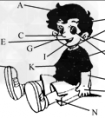根据下列句子所给的汉语或英语注释,写出句子空缺处各单词(每空限填一词)。 1. Tree Planting Day comes in ________(三月) in China. 2. Reading Harry Potter has beco-九年级英语
2.以-es或-s结尾的名词末尾加"'s"。例如:
the students' books
Teachers' Day
my boss' office
a girls' dormitory
3.有些表示时间、距离、度量衡、价值、自然现象、国家、城镇等无生命东西的名词,也可以加's构成所有格。例如:
today's newspaper five minutes'walk a ton's weight a dollar's worth of stamps the moon's rays
4.表示两者共同拥有的人或物(共有)时,只需要后一个名词加's(或')即可。如果表示两者各自的所属关系(各自所有),则每个名词词尾都加上's(或')。例如:
Joan and Jane's room(房间属二人共同所有)
Joan's and Jane's room(指Joan和Jane各自的房间)
5.'s所有格所修饰的词的省略现象
a、表示诊所、店铺或某人的家等地点名词,其名词所有格后的被修饰语常常省略。例如:
I met her at the doctor's(office).我在诊所遇见了她。
He has gone to the tailor's(shop).他到服装店去了。
She went to Mr.Black's(house)yesterday.她昨天到布莱克先生家去了。
b、名词所有格所修饰的词,如果前面已经提到过,往往可以省略,以免重复。例如:
Whose pen is this?It's Tom's.这是谁的钢笔?是汤姆的。
The bike is not mine,but Wang Pinpin's.这辆自行车不是我的,是王品品的。
二、of 所有格的用法
of 所有格由of 加名词构成,其用法归纳如下:
1.of所有格一般用于无生命的东西的名词中。例如:
a map of the world
the story of a hero
the windows of the room
the title of the film
2.用于名词化的词。例如:
the sticks of the blind 盲人的拐杖
3.修饰词较多时也可用of所有格。例如:
the very long and graceful tail of the black cat 黑猫的又长又美的尾巴
4.表示有生命的东西的名词,有时也可以用of所有格。例如:
the children of the family 那家的孩子们
某些of所有格和's所有格可以互换。
the son of a poor peasant=a poor peasant's son 一个贫农的儿子
但有时含义却不相同,请比较下面的例子:
an old woman's story(一个老妇人讲自己的身世)
the story of an old woman(别人讲一个老妇人的身世)
三、's所有格和of所有格可以表示下面的关系:
1.所有关系
the students'reading room 学生阅览室
2.主谓关系
the arrival of the train 火车的到达
3.动宾关系
the search of knowledge 知识的探究
4.同位关系
the name of Kate 凯特这个名字
四、双重所有格及其用法
's所有格和of所有格两种所有格形式结合在一起,构成"of+所有格"形式,即双重的所有格。
它通常表示部分观念,即全体中的一部分,在意义上与"one of..."相似,它主要修饰of短语之前的那个名词。
此外,双重所有格与指示代词连用时,常带有感情色彩,如赞赏、不满、厌恶等。它的主要形式如下:
1.名词+of+名词性物主代词。例如:
a good friend of mine 我的一个好朋友
an interesting story of his 他的有趣的经历
2.名词+of+'s所有格。例如:
He is a friend of my sister's.(=one of my sister's friends)他是我姐姐的一个朋友。
Look at that long nose of Jack's.看杰克的那个长鼻子。(感情色彩)
试比较:
a picture of Xiao Zhang 小张(本人)的照片
a picture of Xiao Zhang's 小张(具有的照片中)的一张照片
此外,不定冠词、数词、某些不定代词(some,any,many,no,few等)以及which等限定词,
一般不与形容词性物主代词或's所有格等一起放在名词前修饰名词,而采用of所有格或双重所有格形式。例如:
most of the students 学生中的大多数
three of them 他们中的三个人
I have read some books of his.我读过他的一些书。
Which book of Qiong Yao's have you read?你读过琼瑶的哪一本书?
考点名称:副词
- 副词:
是一种用来修饰动词、形容词、全句的词,说明时间、地点、程度、方式等概念的词。副词是一种半虚半实的词。
副词可分为:地点副词、方式副词、程度副词、疑问副词和连接副词。
副词连用顺序:程度副词+方式副词+地点副词+时间副词。 副词分类:
1、时间副词有三类:always, often, usually, sometimes, never, ever, hardly等一般位于系动词、情态动词和助动词之后,实之前义动词
1)表示发生时间的副词:
It’s beginning to rain now! 现在开始下雨了!
2)表示频繁程度的副词,也称频度副词always, often, usually, sometimes, never, ever, hardly等一般位于系动词、情态动词和助动词之后,实之前义动词:
She often changes her mind. 她常改变主意。
3)还有一些其他表示时间的副词:
He has just had an operation. 他刚动过手术。
2、地点副词:
1)有不少表示地点的副词:
She is studying abroad. 她在国外留学。
2)还有一些部分与介词同形的副词。它们与介词同形,跟宾语的是介词,否则是副词:
①用作介词:Stand up! 起立!
②用作副词:A cat climbed up the tree. 猫爬上了树。
3)以where 构成的副词也是地点副词:
It’s the same everywhere. 到处都一样。
3、方式副词:
carefully, properly(适当地), anxiously(焦虑地), suddenly, normally(正常地), fast, well, calmly(冷静地), politely(有礼貌地), proudly(自豪地), softly, warmly ,slowly
4、程度副词:
much,little, very,rather(相当),so,too,still, quite, perfectly(完美地), enough, extremely(非常), entirely(整个),almost, slightly(细小地), hardly.
5、疑问副词:
how, when, where, why.
6、关系副词:
when, where, why.等。
7、 连接副词:
therefore(因此),moreover(此外),however,otherwise(另外的),then,when ,where,how,why等。副词的语法作用:
副词在句中可作状语,表语,补语,定语。
He works hard. (作状语)
他工作努力。
You speak English very well. (作状语)
你英语讲的相当好。
Is she in ? (作表语)
她在家吗?
Let's be out. (作表语)
让我们出去吧。
Food here is hardly to get. (here作定语,hardly作状语)
这儿很难弄到食物。
Let him out!(作补语)
让他出去!
修饰名词的副词放在被修饰词之后
a. The villagers there are busy getting in wheat.不同类型副词的用法比较:
方式副词:
1)英语中有大量方式副词,说明行为方式(回答how的问题):
How beautifully your wife dances. 你夫人舞跳的真美。
2)还有相当多的副词,表示某些情绪:
She smiled gratefully. 她感激的笑了笑。
3)还有一些以-ly结尾的副词,表示动作发生的状况:
He left the town secretly. 他悄然离开了这座城市。
程度副词和强调副词 :
1)程度副词可修饰动词,表示“到某种程度”: Is she badly hurt? 她伤得重吗?
[说明] 这类副词除修饰动词外,还可修饰形容词(a)或另一副词(b):
a. fairly simple 相当简单 quite correct 完全正确
b. wonderfully well 好极了 do it very quickly 干得很快
2)much 是一个特殊的程度副词,它可以:
a. 修饰形容词等:
I’m not much good at singing. 我唱歌不太好。
b. 修饰比较级:
You sing much better than me. 你比我唱的好多了。
Their house is much nicer than ours. 他们的房子比我们的好多了。
疑问副词和连接副词:
1)疑问副词:疑问副词用来引导特殊问句:
how: How is your grandmother? 你奶奶身体好吗?
where: Where does she come from? 她是哪儿人?
when: When can you come? 你什么时候能来?
why: Why was he so late? 他为什么来得这么晚?
2)连接副词:连接副词意思和词形都和疑问副词一样,但都引导从句或与不定式连用:
how: Do you know how to start this machine? 你知道这台机器怎样启动吗?
where: I don’t know where he lives. 我不知道他住在哪儿。(引导宾语从句)
when: Tell me when you’ll be ready. 告诉我你什么时候准备好。(引导宾语从句)
why: That’s why I came round. 这就是我来的原因。(引导表语从句)
一些其它类型的副词,如表示方向的副词:
Let’s go inside. 咱们到里面去。
Take two steps forward. 向前走两步。- 副词的位置:
1、实义动词前,be动词、情态动词之后。
I am also Bush.
I can also do that.
I also want to play that games.
I get up early in the morning everyday. 我每天早早起床。
He gave me a gift yesterday. 他昨天给了我一件礼物。
She didn't drink water enough. 她喝的水不够。
The train goes fast. 火车跑得快。
We can go to this school freely. 我们可以免费到这家学校学习。
They left a life hardly then. 当时他们的生活很艰难。
- 最新内容
- 相关内容
- 网友推荐
- 图文推荐
| [家长教育] 孩子为什么会和父母感情疏离? (2019-07-14) |
| [教师分享] 给远方姐姐的一封信 (2018-11-07) |
| [教师分享] 伸缩门 (2018-11-07) |
| [教师分享] 回家乡 (2018-11-07) |
| [教师分享] 是风味也是人间 (2018-11-07) |
| [教师分享] 一句格言的启示 (2018-11-07) |
| [教师分享] 无规矩不成方圆 (2018-11-07) |
| [教师分享] 第十届全国教育名家论坛有感(二) (2018-11-07) |
| [教师分享] 贪玩的小狗 (2018-11-07) |
| [教师分享] 未命名文章 (2018-11-07) |






